oil level CHRYSLER SEBRING CONVERTIBLE 2004 2.G Owners Manual
[x] Cancel search | Manufacturer: CHRYSLER, Model Year: 2004, Model line: SEBRING CONVERTIBLE, Model: CHRYSLER SEBRING CONVERTIBLE 2004 2.GPages: 271, PDF Size: 5.31 MB
Page 91 of 271
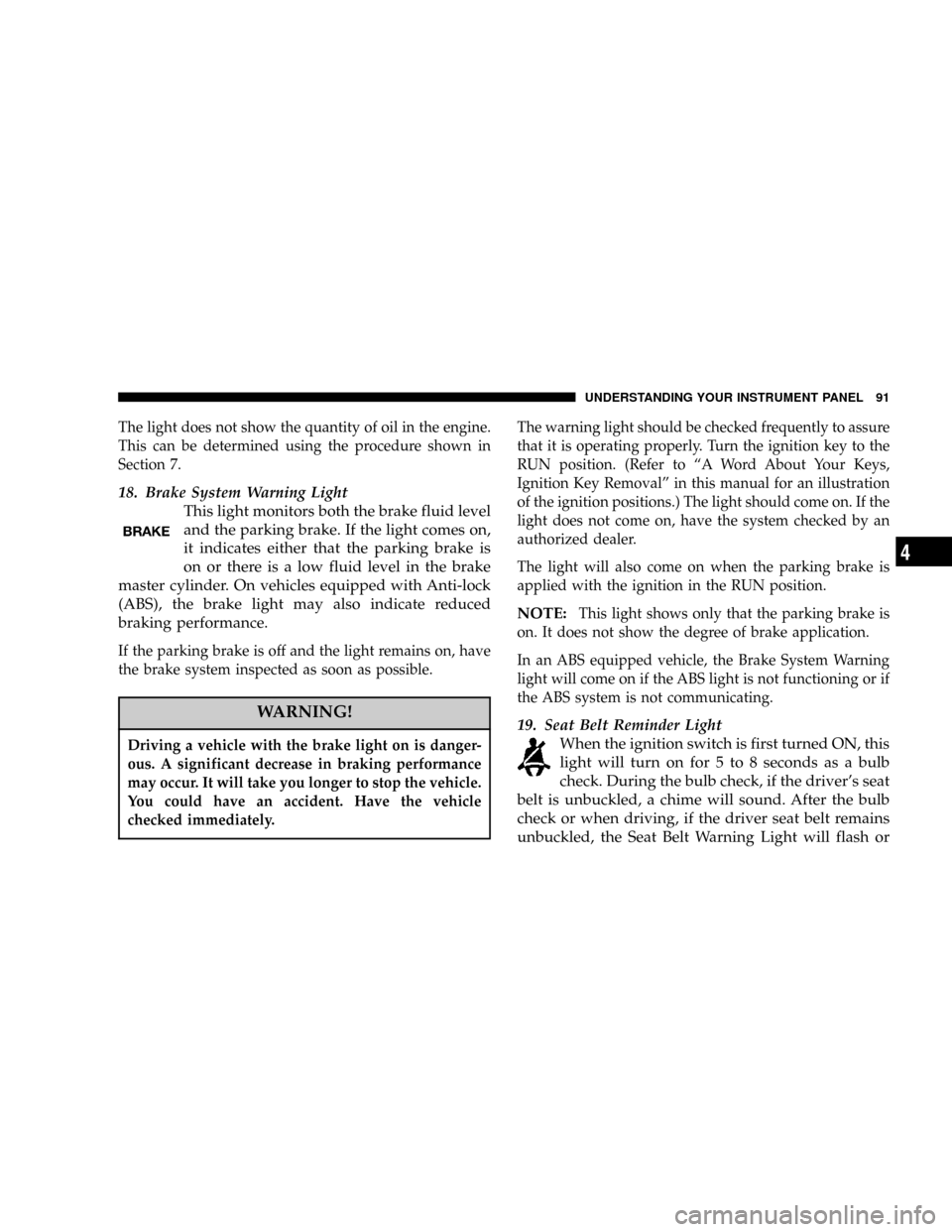
The light does not show the quantity of oil in the engine.
This can be determined using the procedure shown in
Section 7.
18. Brake System Warning Light
This light monitors both the brake fluid level
and the parking brake. If the light comes on,
it indicates either that the parking brake is
on or there is a low fluid level in the brake
master cylinder. On vehicles equipped with Anti-lock
(ABS), the brake light may also indicate reduced
braking performance.
If the parking brake is off and the light remains on, have
the brake system inspected as soon as possible.
WARNING!
Driving a vehicle with the brake light on is danger-
ous. A significant decrease in braking performance
may occur. It will take you longer to stop the vehicle.
You could have an accident. Have the vehicle
checked immediately.
The warning light should be checked frequently to assure
that it is operating properly. Turn the ignition key to the
RUN position. (Refer to ªA Word About Your Keys,
Ignition Key Removalº in this manual for an illustration
of the ignition positions.) The light should come on. If the
light does not come on, have the system checked by an
authorized dealer.
The light will also come on when the parking brake is
applied with the ignition in the RUN position.
NOTE:This light shows only that the parking brake is
on. It does not show the degree of brake application.
In an ABS equipped vehicle, the Brake System Warning
light will come on if the ABS light is not functioning or if
the ABS system is not communicating.
19. Seat Belt Reminder Light
When the ignition switch is first turned ON, this
light will turn on for 5 to 8 seconds as a bulb
check. During the bulb check, if the driver's seat
belt is unbuckled, a chime will sound. After the bulb
check or when driving, if the driver seat belt remains
unbuckled, the Seat Belt Warning Light will flash or
UNDERSTANDING YOUR INSTRUMENT PANEL 91
4
Page 125 of 271

NOTE:The defroster turns off automatically after 15
minutes of operation. Each later activation will allow 10
minutes of operation.
Side Window Demisters
A side window demister outlet is at each end of the
instrument panel. These non-adjustable outlets direct air
toward the side windows when the system is in either the
FLOOR, MIX, or DEFROST modes. A small amount of air
is directed to the side window demisters in BI-LEVEL
mode as well. The air is directed at the area of the
windows through which you view the outside mirrors.
Windshield and Side Window Fogging
Interior fogging on the windshield can be quickly
removed by using the defrost position on the mode
control.
Your side windows may fog on the inside in mild
rainy or humid weather. To clear the windows,
select the Panel-Air Conditioning mode on the
Mode Control. Point the panel outlets toward the side
windows.
NOTE:Do not use the recirculation mode as it will not
clear windows under these conditions.
Summer Operation
Air conditioned vehicles must be protected with a high-
quality antifreeze coolant to provide proper corrosion
protection and to raise the boiling point of the coolant for
protection against overheating. A 50 % concentration is
recommended.
Winter Operation
The blower air will heat faster in cold weather if you use
only the low blower speeds for the first 10 minutes of
operation. During engine warm up in cold weather, use
the Defrost mode to direct any cold air away from vehicle
occupants. Use of the Recirculate-Air Conditioning Mode
during winter months is not recommended due to the
possibility of window fogging.
NOTE:See Operating Tips chart (for Manual A/C
Control) at the end of this section for suggested control
settings in different weather conditions.
UNDERSTANDING YOUR INSTRUMENT PANEL 125
4
Page 194 of 271
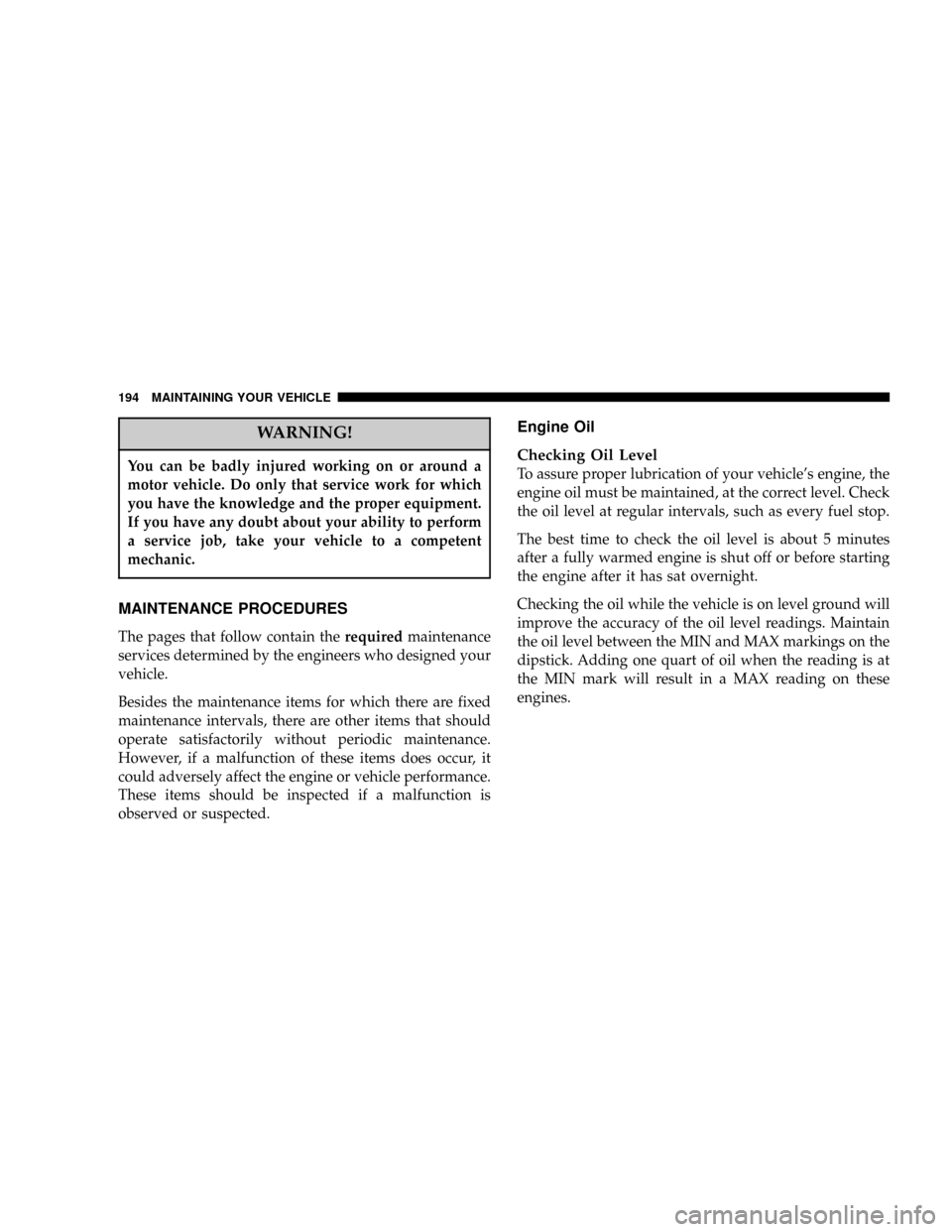
WARNING!
You can be badly injured working on or around a
motor vehicle. Do only that service work for which
you have the knowledge and the proper equipment.
If you have any doubt about your ability to perform
a service job, take your vehicle to a competent
mechanic.
MAINTENANCE PROCEDURES
The pages that follow contain therequiredmaintenance
services determined by the engineers who designed your
vehicle.
Besides the maintenance items for which there are fixed
maintenance intervals, there are other items that should
operate satisfactorily without periodic maintenance.
However, if a malfunction of these items does occur, it
could adversely affect the engine or vehicle performance.
These items should be inspected if a malfunction is
observed or suspected.
Engine Oil
Checking Oil Level
To assure proper lubrication of your vehicle's engine, the
engine oil must be maintained, at the correct level. Check
the oil level at regular intervals, such as every fuel stop.
The best time to check the oil level is about 5 minutes
after a fully warmed engine is shut off or before starting
the engine after it has sat overnight.
Checking the oil while the vehicle is on level ground will
improve the accuracy of the oil level readings. Maintain
the oil level between the MIN and MAX markings on the
dipstick. Adding one quart of oil when the reading is at
the MIN mark will result in a MAX reading on these
engines.
194 MAINTAINING YOUR VEHICLE
Page 203 of 271

Fluid level should be maintained at the proper level
indicated on the side of the reservoir. If necessary, add
fluid to restore to the proper indicated level. With a clean
cloth, wipe any spilled fluid from all surfaces. Refer to
Recommended Fluids, Lubricants, and Genuine Parts for
correct fluid type.
Suspension Ball Joints
There are two upper front and rear suspension ball joints.
Inspect these ball joints whenever under vehicle service is
done. If the seals are damaged, the ball joint should be
replaced.
Body Mechanism Lubrication
Locks and all body pivot points, including such items as
seat tracks, doors,liftgate and hood hinges, should be
lubricated periodically to assure quiet, easy operation
and to protect against rust and wear. Prior to the appli-
cation of any lubricant, the parts concerned should be
wiped clean to remove dust and grit; after lubricating
excess oil and grease should be removed. Particular
attention should also be given to hood latching compo-
nents to insure proper function. When performing other
underhood services, the hood latch, release mechanism
and safety catch should be cleaned and lubricated.
The external lock cylinders should be lubricated twice a
year, preferably in the fall and spring. Apply a small
amount of a high quality lubricant such as MopartLock
Cylinder Lubricant directly into the lock cylinder.
Hood Latch
When performing other under hood services, the hood
latch release mechanism and safety catch should be
inspected, cleaned, and lubricated.
It is important to maintain proper lubrication to insure
that the hood mechanisms work properly and safely.
MAINTAINING YOUR VEHICLE 203
7
Page 205 of 271

Windshield Wiper Blades
Clean the rubber edges of the wiper blades and the
windshield periodically with a sponge or soft cloth and a
mild non abrasive cleaner. This will remove accumula-
tions of salt or road film.
Operation of the wipers on dry glass for long periods
may cause deterioration of the wiper blades. Always use
washer fluid when using the wipers to remove salt or dirt
from a dry windshield. Avoid using the wiper blades to
remove frost or ice from the windshield. Keep the blade
rubber out of contact with petroleum products such as
engine oil, gasoline, etc.
Windshield Wiper Blade Replacement
²
Lift the wiper arm away from the glass.
²Push the release tab and slide the wiper blade assem-
bly away from the wiper arm. Gently place the wiper
arm on the windshield.
²Install the new blade assembly onto the wiper arm tip
until it locks in place.
Windshield Washers
The fluid reservoir in the engine compartment should be
checked for fluid level at regular intervals. Fill the
reservoir with windshield antifreeze (not radiator anti-
freeze) rated not to freeze at -25ÉF (-31ÉC). Operate the
system for a few seconds to flush out the residual water.
MAINTAINING YOUR VEHICLE 205
7
Page 212 of 271
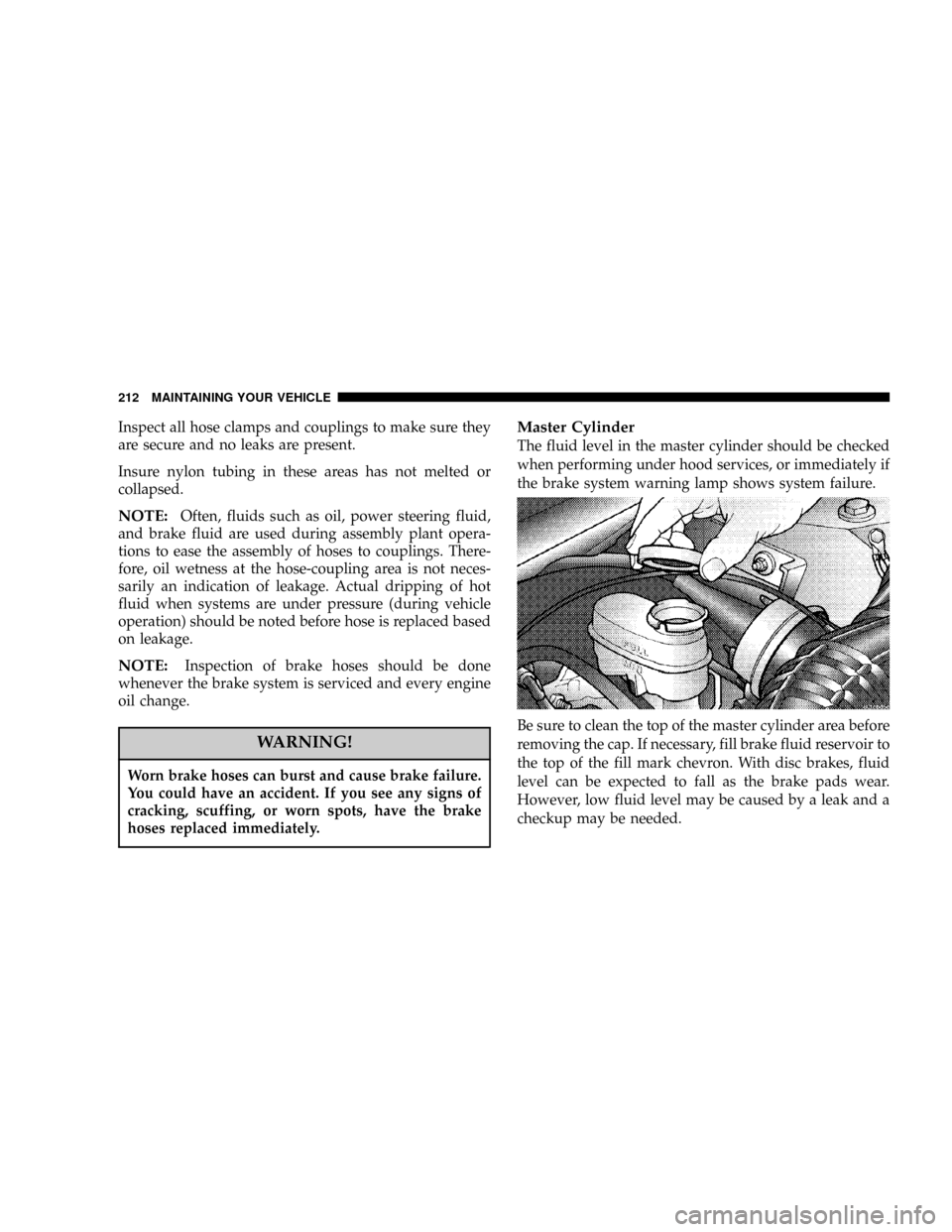
Inspect all hose clamps and couplings to make sure they
are secure and no leaks are present.
Insure nylon tubing in these areas has not melted or
collapsed.
NOTE:Often, fluids such as oil, power steering fluid,
and brake fluid are used during assembly plant opera-
tions to ease the assembly of hoses to couplings. There-
fore, oil wetness at the hose-coupling area is not neces-
sarily an indication of leakage. Actual dripping of hot
fluid when systems are under pressure (during vehicle
operation) should be noted before hose is replaced based
on leakage.
NOTE:Inspection of brake hoses should be done
whenever the brake system is serviced and every engine
oil change.
WARNING!
Worn brake hoses can burst and cause brake failure.
You could have an accident. If you see any signs of
cracking, scuffing, or worn spots, have the brake
hoses replaced immediately.
Master Cylinder
The fluid level in the master cylinder should be checked
when performing under hood services, or immediately if
the brake system warning lamp shows system failure.
Be sure to clean the top of the master cylinder area before
removing the cap. If necessary, fill brake fluid reservoir to
the top of the fill mark chevron. With disc brakes, fluid
level can be expected to fall as the brake pads wear.
However, low fluid level may be caused by a leak and a
checkup may be needed.
212 MAINTAINING YOUR VEHICLE
Page 219 of 271
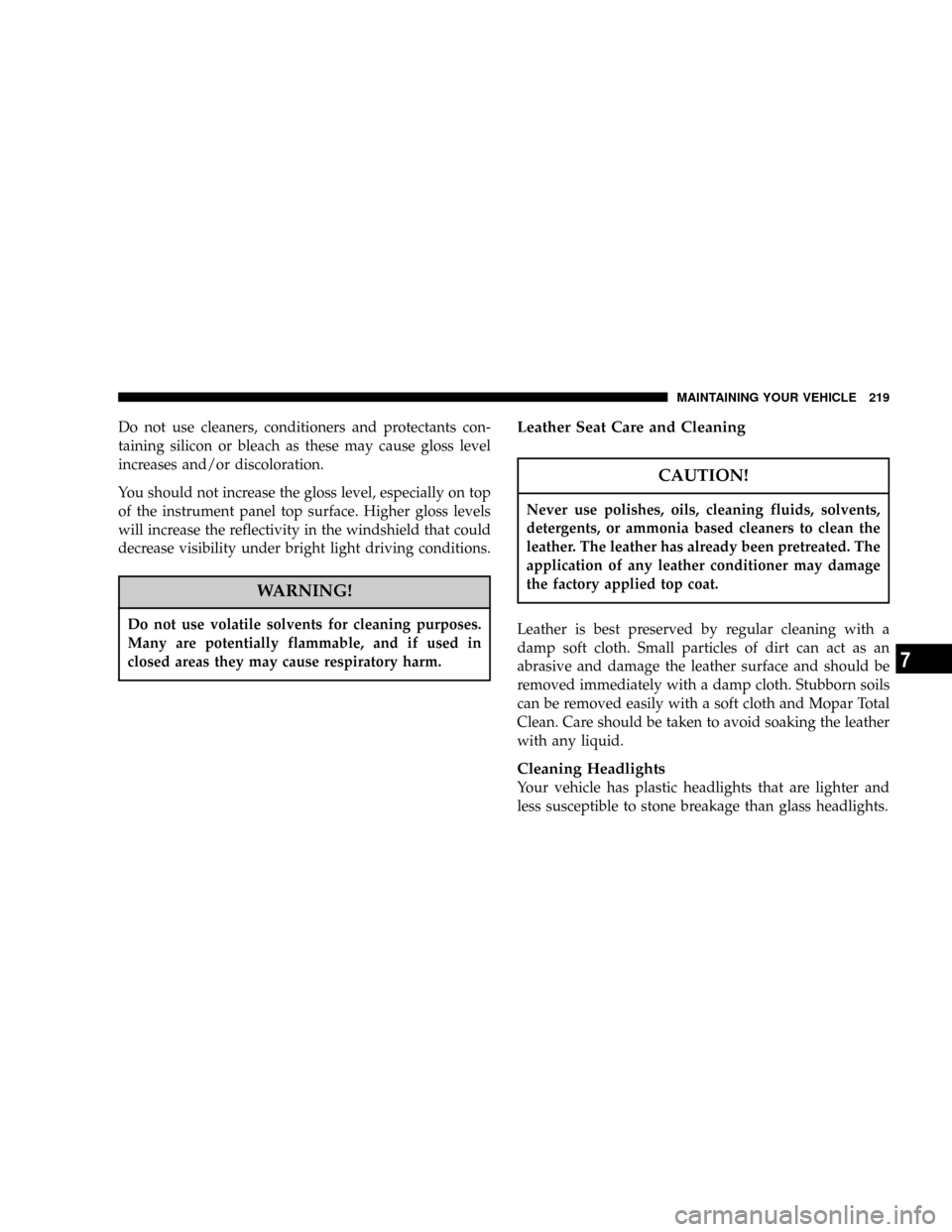
Do not use cleaners, conditioners and protectants con-
taining silicon or bleach as these may cause gloss level
increases and/or discoloration.
You should not increase the gloss level, especially on top
of the instrument panel top surface. Higher gloss levels
will increase the reflectivity in the windshield that could
decrease visibility under bright light driving conditions.
WARNING!
Do not use volatile solvents for cleaning purposes.
Many are potentially flammable, and if used in
closed areas they may cause respiratory harm.
Leather Seat Care and Cleaning
CAUTION!
Never use polishes, oils, cleaning fluids, solvents,
detergents, or ammonia based cleaners to clean the
leather. The leather has already been pretreated. The
application of any leather conditioner may damage
the factory applied top coat.
Leather is best preserved by regular cleaning with a
damp soft cloth. Small particles of dirt can act as an
abrasive and damage the leather surface and should be
removed immediately with a damp cloth. Stubborn soils
can be removed easily with a soft cloth and Mopar Total
Clean. Care should be taken to avoid soaking the leather
with any liquid.
Cleaning Headlights
Your vehicle has plastic headlights that are lighter and
less susceptible to stone breakage than glass headlights.
MAINTAINING YOUR VEHICLE 219
7
Page 238 of 271
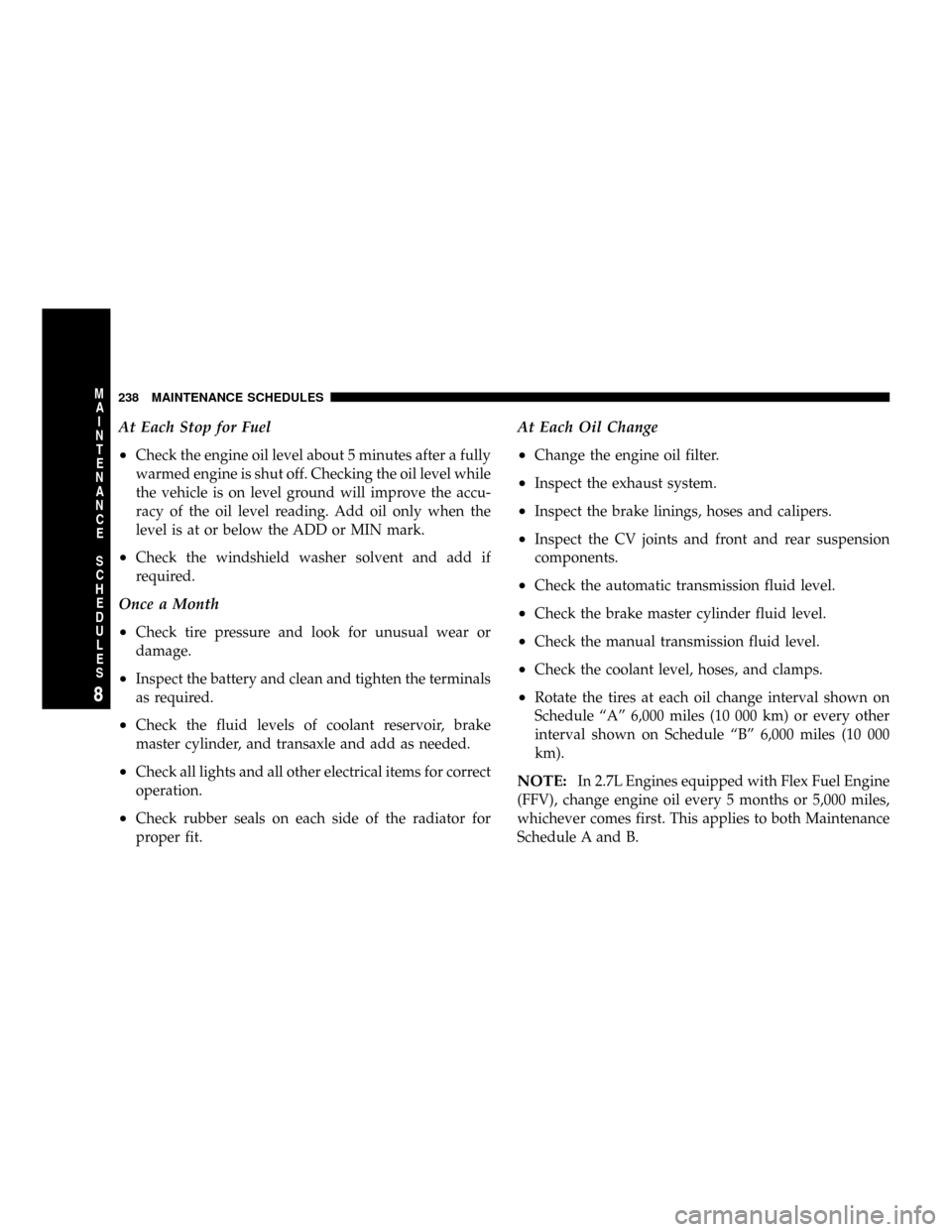
At Each Stop for Fuel
²
Check the engine oil level about 5 minutes after a fully
warmed engine is shut off. Checking the oil level while
the vehicle is on level ground will improve the accu-
racy of the oil level reading. Add oil only when the
level is at or below the ADD or MIN mark.
²Check the windshield washer solvent and add if
required.
Once a Month
²
Check tire pressure and look for unusual wear or
damage.
²Inspect the battery and clean and tighten the terminals
as required.
²Check the fluid levels of coolant reservoir, brake
master cylinder, and transaxle and add as needed.
²Check all lights and all other electrical items for correct
operation.
²Check rubber seals on each side of the radiator for
proper fit.
At Each Oil Change
²
Change the engine oil filter.
²Inspect the exhaust system.
²Inspect the brake linings, hoses and calipers.
²Inspect the CV joints and front and rear suspension
components.
²Check the automatic transmission fluid level.
²Check the brake master cylinder fluid level.
²Check the manual transmission fluid level.
²Check the coolant level, hoses, and clamps.
²Rotate the tires at each oil change interval shown on
Schedule ªAº 6,000 miles (10 000 km) or every other
interval shown on Schedule ªBº 6,000 miles (10 000
km).
NOTE:In 2.7L Engines equipped with Flex Fuel Engine
(FFV), change engine oil every 5 months or 5,000 miles,
whichever comes first. This applies to both Maintenance
Schedule A and B.
238 MAINTENANCE SCHEDULES
8
M
A
I
N
T
E
N
A
N
C
E
S
C
H
E
D
U
L
E
S
Page 262 of 271

Compact Disc Player..................97,102
Compact Spare Tire..................... 155
Compass.............................. 92
Compass Calibration..................... 94
Console............................... 55
Contract, Service....................... 254
Convertible............................ 47
Convertible Boot........................ 50
Convertible Top......................... 47
Convertible Top Maintenance.............. 221
Cooling System........................ 207
Adding Coolant (Antifreeze)............. 208
Coolant Capacity..................... 232
Coolant Level........................ 209
Disposal of Used Coolant............... 209
Drain, Flush, and Refill................. 208
Inspection........................... 207
Points to Remember................... 210
Pressure Cap........................ 209
Radiator Cap........................ 209
Rubber and Plastic Components.......... 211
Selection of Coolant................... 208
Corrosion Protection.................... 216Crankcase Emission Control System......... 200
Cruise Control.......................... 70
Cruise Light........................... 87
Customer Assistance.................... 252
Daytime Running Lights.................. 66
Dealer Service......................... 193
Defroster, Rear Window.................. 124
Defroster, Windshield..................43,124
Diagnostic System, Onboard............... 191
Dimmer Control........................ 65
Dimmer Switch, Headlight................. 67
Dipsticks
Automatic Transaxle................... 214
Disposal
Antifreeze........................... 209
Engine Oil.......................... 197
Door Ajar Warning...................... 14
Door Locks............................ 12
Door Locks, Automatic................... 14
Door Opener, Garage..................... 73
Drive Belts............................ 198
262 INDEX
Page 263 of 271

Driving
On Slippery Surfaces.................. 184
Electrical Outlet, Auxiliary................. 78
Electronic Speed Control.................. 70
Emergency Brake....................... 141
Emergency, In Case of
Jacking............................. 176
Emergency Trunk Release...............20,21
Emission Control System Maintenance....192,236
Engine............................189,190
Block Heater......................... 134
Break-In Recommendations............... 42
Checking Oil Level.................... 194
Compartment.....................189,190
Cooling............................ 207
Oil .............................194,232
Oil Change Interval................... 195
Oil Selection......................... 196
Oil Synthetic......................... 197
Overheating......................... 174
Timing Belt.......................... 200
Engine Oil Viscosity..................196,232Engine Oil Viscosity Chart................ 196
Entry System, Illuminated................. 12
Exhaust Gas Caution.................... 206
Exhaust System........................ 206
Exterior Light Service.................... 226
Filters
Air Cleaner.......................... 198
Automatic Transaxle................... 215
Engine Fuel......................... 198
Engine Oil.......................... 197
Flashers
Hazard Warning...................... 174
Flexible Fuel Vehicles
Cruising Range....................... 170
Engine Oil.......................... 196
Maintenance......................... 171
Replacement Parts.................... 171
Starting............................ 170
Fluid Capacities........................ 232
Fluid Leaks............................ 43
Fluid Level Checks
Automatic Transaxle................... 214
INDEX 263
10